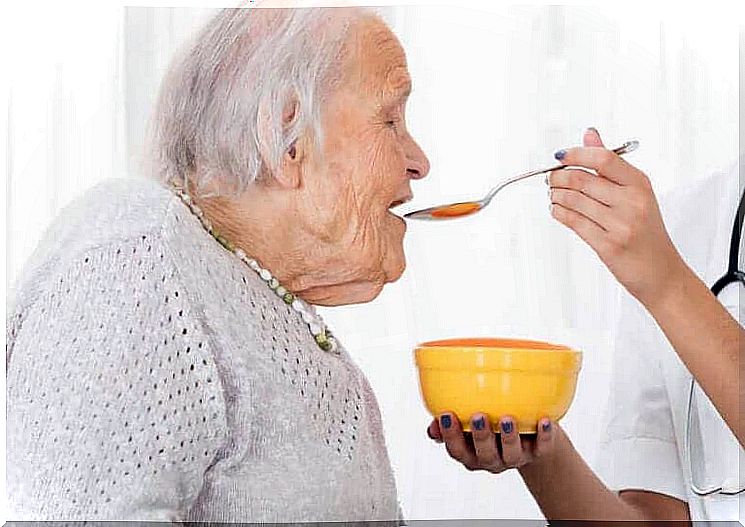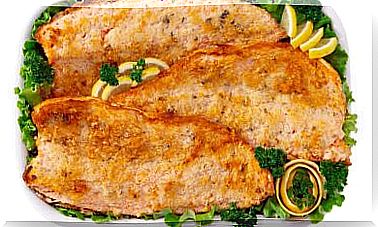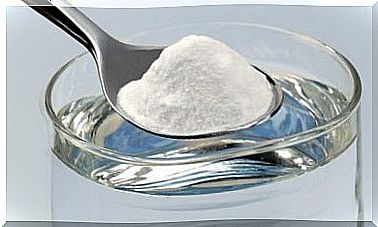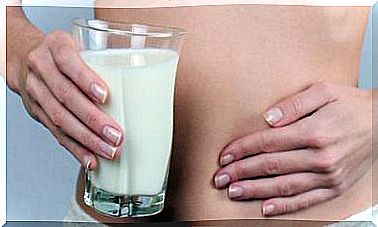How Is Eating With Dysphagia Or A Swallowing Disorder?

In the case of dysphagia, eating should be adapted to the needs of the individual patient. In general , it is important to pay attention to the texture of food, as there is a risk of choking. So what do you need to know about this condition?
For starters, let’s not forget that a normal swallow moves all food from the mouth into the esophagus. It involves the combined action of the structures of the head, neck and chest as well as closing the airways to prevent airway obstruction.
This process is characterized by efficiency. That is, in this way we can absorb all the food and fluids that are necessary for the body and also safety, because it protects the respiratory tract from possible complications.
What is Dysphagia?

The term dysphagia comes from two Greek words: ‘dys’ (difficulty) and ‘phagia’ (eating). It refers to a feeling of difficulty swallowing solid or liquid food and in some cases it can even cause pain.
If a person has difficulty swallowing solids, then this indicates an obstruction problem, while a person with fluid dysphagia has a functional disorder.
Types of Dysphagia
- High or oropharyngeal dysphagia involves changes of oral swallowing, the esophagus, and the larynx. There are problems forming or moving food from the mouth into the esophagus. Patients may cough or choke. Nearly 80% of diagnoses are of this type, according to a publication in the journal Hospital Nutrition .
- Low or esophageal dysphagia refers to changes in the esophagus and causes a feeling of food getting stuck in the throat or chest, making swallowing difficult. This type represents almost 20% of diagnosed cases of dysphagia.
Causes
There are several factors associated with the development of dysphagia. We will list some of the most common reasons below. For example, consider problems such as:
- development problems.
- cerebral palsy.
- tumors in the head, esophagus, larynx, mouth.
- narrowing of the esophagus.
- neurological problems such as acute cerebrovascular accident (CVA or stroke), Parkinson’s disease, multiple sclerosis (MS), traumatic brain injury (TBI), dementia, Alzheimer’s, etc.
- postoperatively or after treatment of a number of diseases.
As for the symptoms, it is important to keep in mind that it can also lead to an increased need to drink water with meals. A feeling of food getting stuck in the throat and frequent respiratory infections are also common.
Health Effects
In general, people with dysphagia do not feel safe because they are afraid of choking and as a result they consume less food and drink. This, in turn, negatively affects their health, as it leads to complications such as:
- malnutrition
- dehydration
- inhalation of food and fluid
- pneumonia
- respiratory infections
Tips

- It is important to maintain a safe posture, sitting with your back against the back of the chair and feet flat on the floor.
- When one is in bed, experts recommend maintaining a 45º position, head forward.
- It is also important not to feed someone who is sleepy or tired to avoid suffocation.
- Avoid distractions during meals.
- Avoid using syringes or straws.
- Provide a pleasant and quiet environment.
- Monitor the patient closely during meals.
- Practice good oral hygiene to reduce the risk of respiratory infections from aspiration.
Anyone can suffer from dysphagia. However, there is a greater risk in older people. This is because their muscles are weaker, even when swallowing. This makes them more prone to developing neurological disorders.
Conclusion
As we mentioned, the degree of dysphagia determines the texture of the food a person can eat. For example, to get the right texture, it is possible to thicken liquids with commercial products.
Similarly, we can puree solids to get the texture of mashed potatoes, custard or water. It is also possible to use dyes to improve the appearance of dishes. Furthermore, it is crucial that the final textures are homogeneous, so not sticky and without lumps.
Another important aspect is the volume. In the same way, if necessary, the use of nutritional supplements can be considered at the direction of a professional (the doctor, dietician or speech therapist) .
In general, given all of the above, we should understand that the sooner this condition is detected, the better. This means that it will be easier to slow down the progression by, for example, doing exercises, avoiding complications and taking care of the patient’s health.









